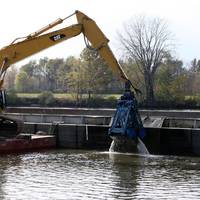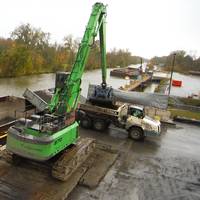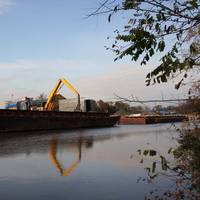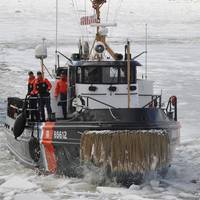Officials Urge EPA to Remove Toxic 'Forever Chemicals' from the Hudson River

U.S. Senator Kirsten Gillibrand earlier this month stood with local leaders and environmental advocates at Albany City Hall to demand that the Environmental Protection Agency (EPA) take additional action to clean up polychlorinated biphenyl (PCB) “forever chemicals” in the Hudson River.PCBs are toxic manmade chemicals that can linger in water and soil for decades. Exposure is associated with a variety of serious health conditions, including cancer.From 1947 to 1977, General Electric dumped 1.2 million pounds of PCBs into the Hudson River north of Albany.
Dredging in Hudson River Nears Completion
After six years of digging, General Electric Co. expects to finish this year removing some 2.7 million cubic yards of contaminated river sediment in upper Hudson River in Waterford under its landmark Superfund agreement with the federal Environmental Protection Agency. AP reports that long after the last barge dredging toxins from the bottom of the upper Hudson River moves on, scientists will track the slow fade in contamination levels. General Electric expects to remove enough sediment to fill two Empire State Buildings, but environmental advocates say without more work, 40 percent of the PCBs will be left in the river. After six years of digging, crews will have removed most of the PCBs on the river bottom discharged decades ago from two GE plants upriver.
The Critical Link in Hudson River Remediation Project

Approximately three times a week, for six months of the year, trains depart from upstate New York, en route to one of three EPA-approved long-term disposal facilities. The trains, which are loaded with dewatered, PCB-containing sediments, represent the last leg of a complex environmental dredging project undertaken by General Electric Co. in New York’s Upper Hudson River. To keep these trains on schedule, GE relies on two purpose-built material handlers from SENNEBOGEN, an 870 R-HD and an 870 M…
Sixth Season of Hudson River Dredging Begins

U.S. Environmental Protection Agency Regional Administrator Judith A. Enck announced the start of the sixth, and final, season of dredging of PCB-contaminated sediments from the bottom of the Hudson River. The historic dredging project – one of the largest and most complex cleanups in Superfund history – began in 2009. The EPA is overseeing the dredging project that is being conducted by General Electric Company (GE) under the terms of a 2006 legal agreement. According to GE, the company has invested more than $1 billion on the cleanup project to date.
Toxics Dredging Resumes in the Hudson

The U.S. Environmental Protection Agency (EPA) announced today that dredging operations are expected to resume on Wednesday in the Upper Hudson River. In 2014, dredging will begin south of Schuylerville, New York and proceed south towards Troy. Dredging will also occur in a two-mile section of river near Fort Miller that is not easily accessed by boat. Dredging is being conducted to remove sediment from the river bottom that is contaminated with polychlorinated biphenyls (PCBs).
Phase 2 of Hudson River Cleanup
The U.S. Environmental Protection Agency (EPA) announced that the dredging of sediment contaminated with polychlorinated biphenyls (PCBs) has resumed in the Upper Hudson River, marking the start of the second and final phase of the Hudson River cleanup. The historic dredging project targets approximately 2.4 million cubic yards of PCB-contaminated sediment from a forty- mile section of the Upper Hudson River between Fort Edward and Troy, NY. PCBs are potentially cancer-causing in people and build up in the fat of fish and mammals, increasing in concentration as they move up the food chain. The primary risk to humans is the accumulation of PCBs in the body from eating contaminated fish.
Photo: Coast Guard Cutter Breaks Ice on the Hudson

The crew of the U.S. Coast Guard Cutter Wire conducts icebreaking operations on the Hudson River, near Rhinebeck, N.Y., Tuesday, Feb. 8, 2011. The Wire's crew, along with other Coast Guard cutter crews, are in the upper Hudson River to help clear safe paths for ships carrying vital resources to upstate New York residents.





